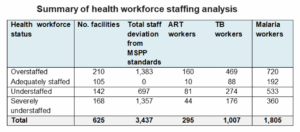Health Facility Workforce Efficiency for HIV, TB and Malaria in Haiti
THE PROBLEM
Haiti is still heavily dependent on donor funds to provide HIV, tuberculosis (TB) and malaria services. A large share of Global Fund (GF) resources in Haiti is directed to pay salaries and fees of service providers. In 2019, the GF invested 7.8M USD in these human resources for health (HRH) for the three diseases (3.9M for HIV, 2.3M for TB and 1.6M for malaria).
The Global Fund now wants to know whether GF staff currently employed in these facilities are efficiently deployed, including human resources for health (HRH) funded by the government. More specifically, the Global Fund wants to solve the following policy questions:
- Do facilities have the right numbers of staff according to national norms?
- Is the current staff allocation appropriate according to workload/productivity, especially for HIV, TB, and malaria?
- Where are GF-funded staff located and what actions can the GF take to ensure the right number of health workers are in the right places (hire, fire, redeploy)?
- What national policy and HR management actions might be taken to improve the allocation and productivity of the health workforce?
THE PHAROS SOLUTION
Given the magnitude of these investments, the Global Fund through Population Services International (PSI), the Fund’s Principal Recipient in Haiti, commissioned Pharos Global Health Advisors to conduct a Health Facility Analysis in Haiti to determine if the current human resource allocation leads to higher health worker productivity or if opportunities exist to reallocate resources, particularly GF-funded personnel, to improve the productivity of health workers who provide services for HIV, TB and malaria in Global Fund-funded facilities.
Our analysis had two main objectives. First, to describe and analyze how human resources for health are distributed across health facilities in Haiti, by health facility type and department – utilizing staffing norms for different types of health facilities in Haiti established by the Ministry of Health (MSPP). Second, to use utilization information for HIV, TB and malaria services to calculate and measure the productivity of workers who deliver HIV, TB and malaria services
Our analysis showed that Haiti could redistribute 1,383 “excess” staff, enough to cover the deficit of 1,357 in severely understaffed facilities (see table below). This suggests that while HRH scarcity might be a problem, Haiti still has an opportunity to increase service productivity by reallocating existing resources.
The analysis carried out by Pharos is the first attempt to analyze HRH distribution and its association with productivity for HIV, TB and malaria in Haiti. The results showed clear opportunities (“quick wins”) for the Global Fund to redistribute HRH investments within and across the ten departments in Haiti. If the government, PEPFAR, and other funders follow similar reallocations, the distribution of staff across health facilities could be markedly improved. Facilities with exceptionally low productivity could also be targeted for reassessment and actions to remedy this problem, either by increasing the amount of services delivered in HIV, TB, and malaria, or by reassigning staff to other facilities with few staff than the norms and heavy workloads.
LOOKING AHEAD
The results were presented to PSI and the GF country team. Given the relevance and possible implications of these results in the implementation of new interventions thought the new HRSS grant 2021-2023, Pharos will also present the results to the Budgetary Management Unit (Unité de Gestion Presupuestal) and the World Bank.
Status: Completed, July 2020
Team Members Involved: Robert Hecht, Diana Bowser, Leulsegged Mekonen and Diana Gonzalez
For more information, contact us at [email protected].

